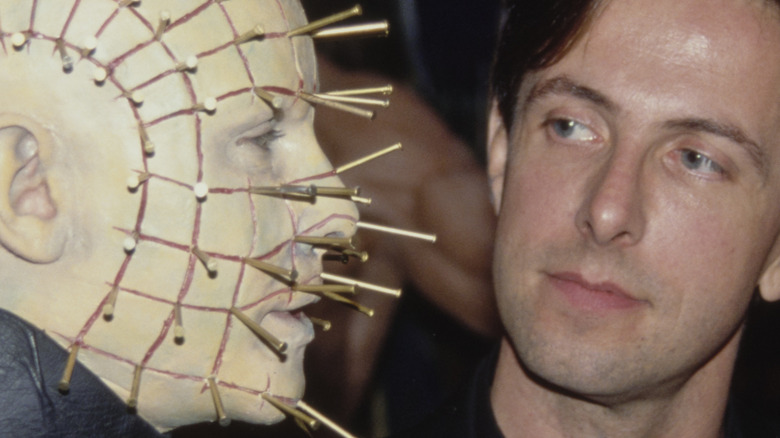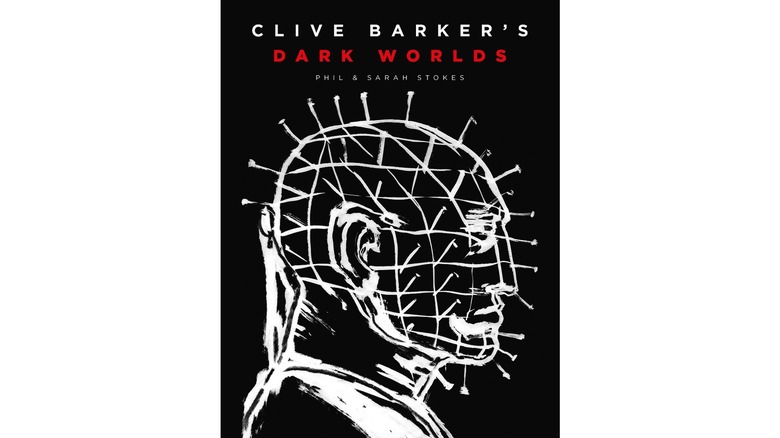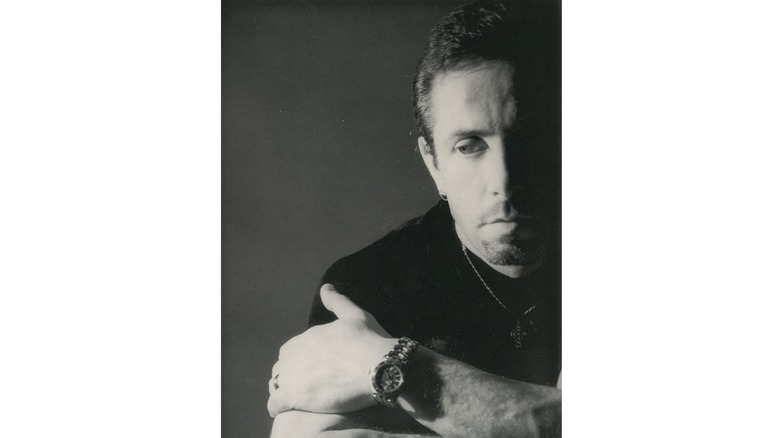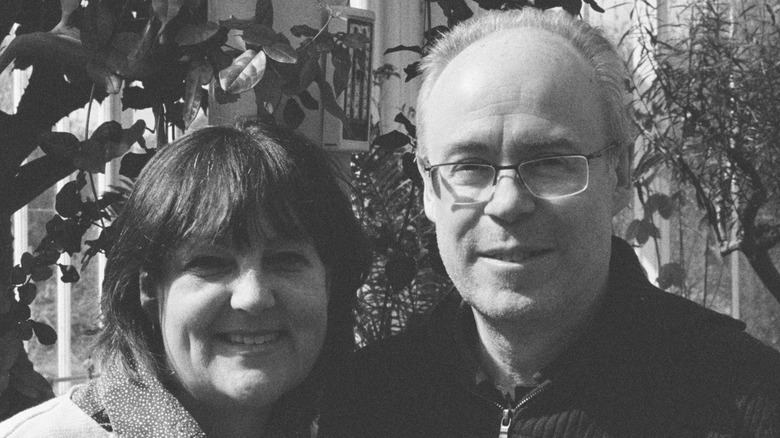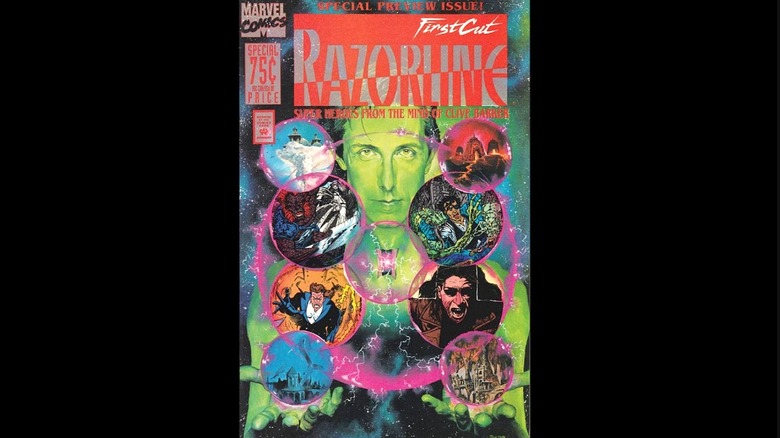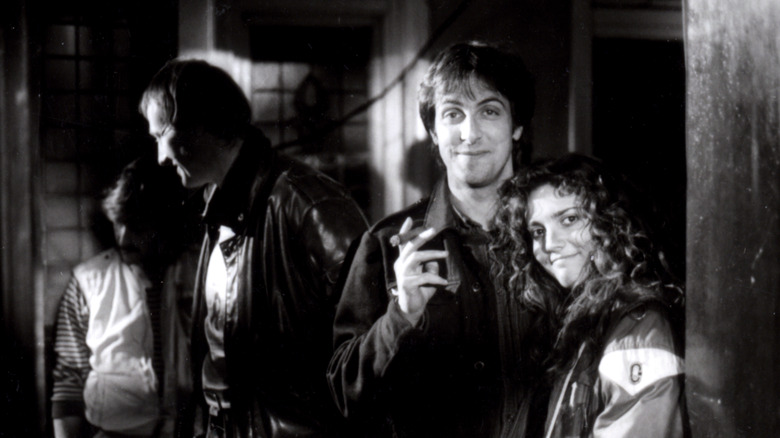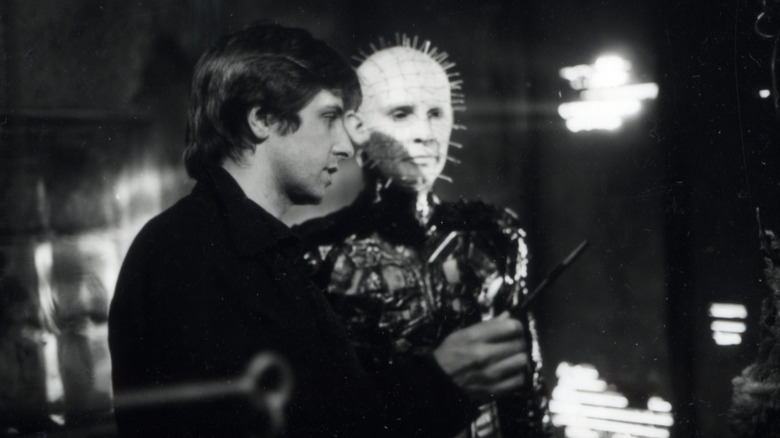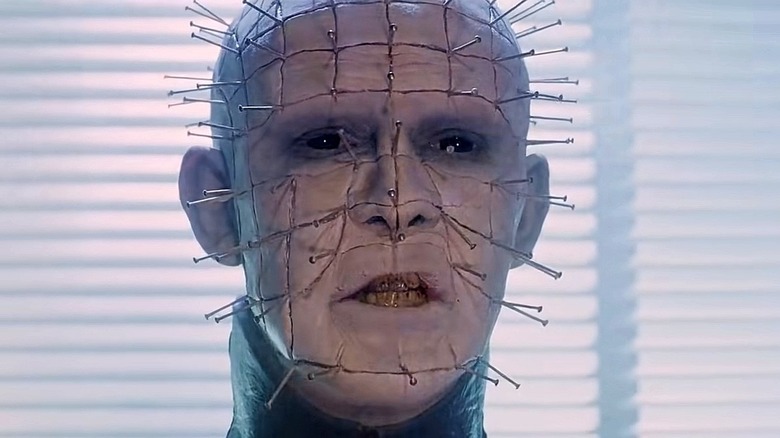Archivists And Authors Phil And Sarah Stokes Examine Clive Barker's Dark Worlds - Exclusive Interview
The newly reimagined Hulu film version of "Hellraiser" no doubt serves as a testament to lasting impact of the work of Clive Barker, considering that it was just over 35 years ago that the legendary novelist-writer-director released the original version of the film.
For Barker's longtime friends and archivists Phil and Sarah Stokes, "Hellraiser" only represents a small corner of the artist's sprawling imagination. As such, nearly 25 years after they first started logging Barker's immense body of work, the Stokes have finished compiling endless amounts of material relating to the artist's life and career for the new book "Clive Barker's Dark Worlds" (Abrams Books). Available in stores and online October 18, "Clive Barker's Dark Worlds" is a meticulously constructed 352-page chronicle detailing Barker's vast array of creative endeavors dating back more than 50 years.
The Stokes' history with Barker is a unique one. Beginning as fans of his work who started the website Revelations, the authors continued to assemble materials from several different avenues of Barker's artistic life running up to the publication of the book. Complimented by clippings and media notices about Barker's efforts, "Clive Barker's Dark Worlds" covers it all, from his processes as a book and short story author to his personal notes and poetry, as well as his film and stage work, sketches, painting, photography, and even his forgotten Marvel Comics line.
In an exclusive interview, Phil and Sarah Stokes detailed for Looper the endless hours of work they put into writing and compiling the materials for "Clive Barker's Dark Worlds," and they gave their thoughts about why the iconic artist's work remains timeless.
50 years of raising hell
"Clive Barker's Dark Worlds" encompasses 50 years in his career and obviously "Hellraiser" is a big part of that, but what part of Clive's world do you hope finally gets its due with this book? Is there a specific area of his career that people maybe haven't focused on as much as maybe they should be about Clive?
Phil Stokes: We saw this as a huge challenge because it is 50 years. It's actually a bit more than 50 years. He's [just celebrated his] 70th birthday [on October 5]. We first came across him with the "Books of Blood," which he sold as a deal when he was just about to turn 30. From the "Books of Blood" to today, that's 40 years.
What we were really intrigued [about] was where did he come from, or how did he suddenly come out of almost nowhere? When "Hellraiser" broke on the screens, and then he had his novel "Weaveworld" came out a month afterwards, there were two really important pieces of work that really spoke to us, and we wanted to know where he'd come from.
To a certain extent, this book is also helping us to go back and remember all of the reasons why we fell in love with his work. There are areas where some people know he's very active. In the last few years, a lot more people have come to know that he's a painter because there's been a series of books about his paintings, but not many people know his photography. Not many people know he's a poet. In many cases, it's because poetry is a piece of work that he hasn't yet shared with the world. Over the next few years, we're going to see a lot more of Clive's photography and his poetry get showcased.
It's not about one area that you want people to discover, but much more.
Phil: What the book hopefully does is allows people to look across a breadth of creativity, one where the idea's the important thing, not the medium. If an idea strikes Clive and it looks like it should be a short story, he'll go and write it as a short story. If it doesn't quite work as a short story, he'll put it on a shelf, and it'll get repurposed as a comic book two years later, or it'll come back in a different form.
What we loved was seeing the themes that have been with Clive throughout his career and the way that they've bubbled up at the right moment to come out into a project which is shared with the world. We've loved that process.
Dream reader
I was completely fascinated by the revelation in your book about Clive interpreting his dreams. He literally takes those dreams when he wakes up and puts something down on paper right away, and from there it will probably evolve into something else.
Sarah Stokes: It's fascinating, but I also I find it's really brave as well, because if I jotted down my half thoughts after a night's dreaming or whatever, it's not going to be particularly cogent. Clive has the artistic confidence to keep those things, to take them, to jot them down, and as Phil said, wait for them to gestate into the right medium.
You both became fascinated with his Clive's works 40 years ago with the "Books of Blood." Is that when you two began working with him?
Phil: We didn't start working with Clive at that point. It's been quite a long journey. We've put a little bit of an endnote into the book because our publishers encouraged us to say a little bit about why the whole of our work with Clive as a passion project. We first interviewed Clive back in about 1999. We've been running a website ever since then. The clivebarker.info website, which is Revelations, we've been running since 1998, '99.
Over that period, we have always been fascinated about saving the scraps of paper, saving that half-illustration, which we could see 10 years later turned into something and actually charting that creative journey. In many cases, it's a creative journey that Clive doesn't remember himself, because he's an artist who lives in the moment and doesn't tend to look back at the things that he's done. Therefore, the ideas stay with him, but occasionally he needs to be reminded about the great idea that he had.
If he didn't have that piece of paper to hand, he wouldn't come back. Collating the archive, making sure that this stuff is accessible to him as a working artist, as well as to us who is somebody who wants to understand the creative impulse and the way that it manifests, it has become a beautiful working relationship.
So much material, not enough room to showcase it
Given the fact that there's so much of Clive's artwork and other material assembled for "Dark Worlds," how difficult was it to determine what makes the cut and what doesn't?
Phil: You've hit the nail on the head. We started out planning a book of 300 pages, and that was too much of a challenge. The publishers very kindly granted us another 50 pages to squeeze a bit more in. We've clearly had to make a balance, and what we were attempting to do was to balance the visual with the text, the familiar with the new, the unknown, to balance fact with a little bit of commentary, but really to showcase all of the media. We tried not to leave anything behind. Some things have justified four pages in the book.
Some things have got a passing message in a paragraph to remind us that we might need to go back and say more about it at some point, but we've tried to be comprehensive, to dwell on the areas where we think there's a story to tell or there's something that people might not know, or there's a fact to uncover, which helps illuminate how all of this really fits together.
Clive had a lovely expression many years ago, that he didn't know how all this connected together, but it was a little bit like a patchwork bedspread. Sooner or later, you could see the way that the patchwork connected together and made it one single covering. You couldn't hop from one to the other because it would look random. What we tried to do is take some of that randomness and say, "There's a method behind this."
Sarah, did your ideas of what should go in the book differ from Phil's ideas? How does that process work as two creatives putting your work into one book?
Sarah: We had a lot of those conversations, and to be honest, it threatened to derail us a bit. At the beginning, it was a real challenge. We then went back, and we said, "If we're the average reader, whoever that might be, they're going to expect certain things." There's "Hellraiser," "Candyman," the "Books of Blood," "Weaveworld" — all of those things.
We put those in as way points and then looked at what Clive have been doing in between them. How can we show the journey? What was going on in the background? How can we fill in, if you like, between these big sort of milestones, creative milestones for him? We both had things we wanted in, and we both had things that there wasn't room for.
Phil: We both fight for things and when it really comes to an impasse, Sarah wins. [laughs]
Forgotten works
Clive in the book says that you two know him better than anybody else on the planet. Still, over the process of working on the book, were you were surprised to find out anything that you didn't know about him?
Phil: Not that surprised us, because we live and breathe this stuff, but reminding us of things we'd forgotten ... the projects that perhaps weren't quite as public or the areas which came and went quite quickly, and even sometimes looking back on some of the disappointments. The Marvel Comics line was huge, and then it wasn't there anymore.
[We looked] back at the projects that worked, the projects that didn't, and setting them in the time period. What we tried to do in the book was not really make it a retrospective, but to talk about quotes and comments that were made at the time to try and make it feel fresh as it went through. The greatest surprise for me was reassembling the breadth of things.
What did Clive create for Marvel Comics and why didn't it fully materialize?
Phil: He created something called the "Razorline," which was a planned series of 10 comic lines, of which four were published. The remaining six were due to come out in of late '93, early 1994, and the comics industry contracted at that point. It was more of a sales issue rather than an ideas issue. That's my take looking back.
His involvement in Marvel Comics is interesting. When you think about the Marvel Cinematic Universe, which really began in earnest in 2008 with "Iron Man," do you think Clive's artistic sensibilities would have ever fit into that world with what he created for Marvel?
Phil: Not in the Marvel canon, but that's not what he was trying to do. The comics were to showcase Clive Barker's imagination, not necessarily to make it fit into the Marvel universe. If you look across the totality of what he was creating there, there's almost a Clive Barker Cinematic Universe in there — the CBU, perhaps.
Is there something his fans at large will be surprised with in the book?
Sarah: I'm not sure that we could point to any single thing, because people come to it from a background of knowing the novels or they come with a background of knowing the films. What we hope people will take away is a better understanding of the sheer diversity. Our hope is that everybody will find something in there that they didn't know about or that they knew less well. For me, it would be the breadth of things.
Phil: When we talk to Clive about the book and when we talk to Clive about the ambition for the book, he will readily tell you that there are people who go up to him at signings who know he is an author, but don't know he paints or who know he's a painter, but actually have never seen some photography. There are some people who will only know "Hellraiser," or they'll only know "Candyman" and actually might not even know "Lord of Illusions."
The people come with a focus. Our ambition has been to say, "Those things are brilliant." If those are your entry points into this world, we celebrate that, but there's a bit more to see. Let us help be a guide to show that there's a bit more if you want to dig. If you don't want to dig, that's fine. Love the thing you love.
Clive's collaborators
I had the great fortune to chat with Ashley Laurence recently, whose work with Clive goes back, of course, to 1987 and the first "Hellraiser" movie. How helpful was she in your work on "Dark Worlds" since she and Clive have stayed great friends and collaborators over all these years?
Sarah: We're great friends with Ashley.
Phil: She had no involvement in "Dark Worlds. In fact, she's one of the people who will get an early copy of the book because we are really keen to share this with all the people who Clive has collaborated with over the years, because they're all in there! We've tried to celebrate all of the collaborative working relationships that Clive has had. He's always had this mentality that it's a pretty big sandbox, and people can come and play in the sandbox.
He thrives on other people's input to creative projects. There's Ashley, Nick Vince, Simon Banford, all of the Cenobites, and anyone who's worked with Clive in a creative capacity, plus all the comic book artists. There are some huge names in there. All across the board, if you started to look at his Rolodex, you'd be going and going and going.
What's really cool about Ashley is that she's not only an actor, but like Clive, she's an artist. She's a painter and has her own set of impressive works. Do either of you sit back and think, "There's a reason why Clive and Ashley's friendship and their creative partnership has endured. They have similar artistic sensibilities. Essentially, they get one another."
Phil: It's a great relationship, and both of them are very open to similar creative spirits who are unconstrained. Great creative people like Clive thrive off other great creative people. They're more than the sum of the parts. When you have that sort of working relationship ... Clive will look back over the fact that he's worked with Mick Garris for 40 years. He's worked with people like Nick Vince for 40 years. Some of those relationships endure a long time, and it's because there's a mutual respect for each person who sits in the relationship. There's no such thing as a bad idea, and all of the creativity is celebrated in all media.
Since Clive did the introduction and afterword for the book, is that the ultimate validation to have him write about what you two created?
Phil: I'm glad he doesn't hate it! [laughs] We are pleased, he's pleased, but we did it without him over our shoulder saying, "Put this in, put that in." We're pleased he's pleased, but we're mostly pleased for ourselves that it's telling a story that has been a very important part of our lives, and his friendship is an important part of our lives. If that comes across and he's been happy enough to write about it in his afterword, we're delighted.
The everlasting appeal of Hellraiser
I naturally have to bring up "Hellraiser." What do you think contributes to the "Hellraiser" saga's endurance that holds the fascination of Clive's fans?
Sarah: You can't beat a good story. The best films, the films that we remember, [and] the films that endure in our minds always have a great story. If you layer on top of that, the striking visuals bring such a totally different looking character onto our screens and put [them] in there quietly.
Phil: The quiet piece is a really important part of that. The first film left you with more questions than answers and it didn't feel a need to tie it up in a neat ribbon. Therefore, it gave other people the jumping off point to say, "This is a great story, but there's clearly something behind the story" ... It was a story that had multiple layers that other people could interpret, and clearly, a lot of people have interpreted it over the years.
We tend to enjoy Clive's very singular vision in that first film. It's 35 years since it came out. We are doing a special screening of it here in London at the British Film Institute at the end of October to celebrate that it was a particularly British piece of work that feels American at points. Ultimately, it's hit a global nerve for saying, "There are some things which might disturb and terrify you, but they are also somehow glamorous." You want to know a little bit more, even if it's a bit dangerous. That's why it's endured.
Pinning down memories
There's nothing more exciting than seeing a character that you never could have imagined before. Recalling first time you saw Pinhead on screen, what's your most vivid memory of that time?
Sarah: It's music because it's such a dramatic entrance, but it's carried by the score. It was a, "What is this? What am I looking at?" moment, but the way it was given drama by Christopher Young's score is what led you, that said to you, "This isn't the point where you run away, and you are scared. This is the point where you look more." There's drama here. That's my overriding overarching memory.
Phil: My first encounter with him wasn't the movie; it was in some of the press that came ahead of the movie. What I think the marketing team did a great job of was showing you something that was about to arrive rather than being coy about, 'There's a movie coming out and we're not going to give you any of the really great stills from the movie in advance." Because it was a low-budget movie that was being shot in London in a single house, it's almost like a "Three people in a house get together and bad things happen" story.
To give it a sense of importance beyond its budget [that's why they were] sharing those stills in advance. I would see them in [the magazines] Fangoria or Starburst. It really drew me in to say, "Something different is happening here." This doesn't look like some of the comedic horror films that were coming out at the same time. This one isn't tongue-in-cheek, and this one is going to push you. That striking image was my entry point into the movie to make me even more excited about what I was going to see.
Bringing Barker's artifacts to the public
Have you discussed with Clive the possibility of doing a museum exhibition or traveling installation featuring his work?
Phil: Yes, absolutely. In fact, one of the ambitions for the archive is that we will have an installation, which makes the archive accessible in that way. [It could be] a traveling exhibition or a working archive where people can come and visit and get the pleasure that we get from seeing how a handwritten text moves through to a typed script and then a hand-corrected typed script and the single words that change that make all of the difference to the cadence of a sentence that gets fixed in a final pass as Clive is polishing. That process we want to share with people, and so does Clive.
"Clive Barker's Dark Worlds," written and compiled by Phil and Sarah Stokes is new in stores and online October 18 from Abrams Books.
This interview was edited for length and clarity.
